BIOL 251 Microbiology Lab Exam Practice
1/36
Earn XP
Description and Tags
Name | Mastery | Learn | Test | Matching | Spaced |
|---|
No study sessions yet.
37 Terms
3
Ocular lens
Where you look through (10x magnification)

4-5
Objective lenses
No. ___ & ___
4x, 10x, 40x, 100x magnification.
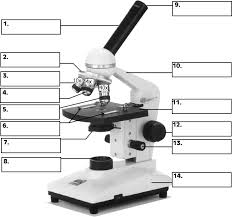
11
Stage
No. ___
Holds the slide.
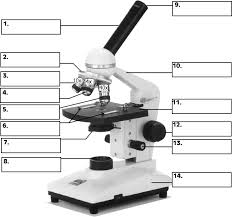
12
Coarse focus
No. ___
Big movements to focus (low power).
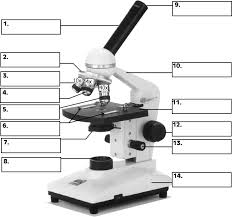
13
Fine focus
No. ___
Small adjustments (high power).
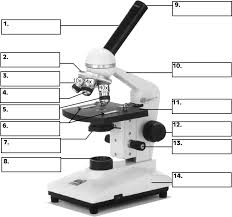
8
Illuminator
No. ___
Illuminates specimen.
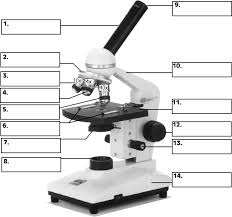
7
Condenser
No. ___
Focuses light on specimen.
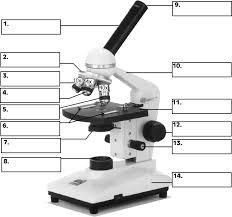
Adjusts light intensity.
No. ___
Adjusts light intensity.
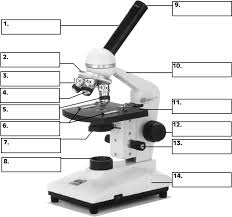
Parfocal lens
Lens system that stays in focus when you change magnification.
Resolution
Magnification
_____: Ability to distinguish two points as separate.
_____: How much larger the image appears.
Objective × Ocular
How to calculate total magnification?
Reduces light refraction at 100x, increases resolution
What is the purpose of using immersion oil with a 100X objective?
Aseptic tecnique
Inoculation
Inoculum
_____ _____: Prevents contamination.
_____: Transferring microbes.
_____: The sample being transferred.
Quadrant streak method
Which method is used to obtain pure cultures?
Differential
Selective
_____ Media: focus on differentiating between multiple microbes
_____ Media: focus on isolating a specific microbe,
indicating hemolytic activity, allowing differentiation between bacterial species based on their ability to lyse red blood cells
What is the function of blood agar?
Alpha
Beta
Gamma
Hemolysis Types;
_____: Partial (green zone).
_____: Complete (clear zone).
_____: None.
Beta
Alpha
Gamma
_____ hemolysis: Total destruction of RBCs → clear, sharp zone around colonies.
_____ hemolysis: Partial breakdown → greenish or brown discoloration around colonies.
_____ hemolysis: No breakdown → media around colonies looks unchanged.
Mannitol
Yellow
Pink
How is MSA selective and differential?
Selective for: Staphylococci (high salt).
Differential for: _____ fermentation (yellow = positive).
Interpretation:
_____: Ferments mannitol (e.g., S. aureus).
_____: Does not ferment (e.g., S. epidermidis).
yellow
no
MSA Interpretation
Growth + _____ color: Positive for mannitol fermentation and tolerant to high salt.
Staphylococcus aureus
Growth + _____ color change (pink/red): Salt-tolerant but does not ferment mannitol.
Staphylococcus epidermidis
No growth: Not salt-tolerant (inhibited by high NaCl).
E. coli, Streptococcus spp.
negative
Lactose
How is EMB agar selective and differential?
Selective for: Gram-_____.
Differential for: _____ fermentation.
Strong
Weak
Positive
EMB Interpretation
Dark purple to black colonies with green metallic sheen: _____ lactose fermenter – produces acid that precipitates dyes
E. coli
Pink/purple colonies without metallic sheen: _____ lactose fermenter
Enterobacter aerogenes
Colorless or transparent colonies: Non-lactose fermenter
Salmonella, Shigella
No growth: Gram-_____ bacteria inhibited by dyes
Staphylococcus, etc.
negative
Lactose
Pink
Colorless
How is MacConkey agar selective and differential?
Selective for: Gram-_____.
Differential for: _____ fermentation.
Interpretation:
_____ colonies: Lactose fermenters.
_____: Non-fermenters.
Clinical Use: Detecting enteric pathogens.
Lactose
non
positive
MacConkey Interpretation
Pink to red colonies: _____ fermenter – acid production lowers pH, turns colonies pink
E. coli, Enterobacter
Colorless or pale colonies: _____-lactose fermenter – no acid, no color change
Salmonella, Shigella
No growth: Gram-_____ bacteria inhibited by bile salts and crystal violet
Staphylococcus, etc.
30-300
Colony forming units
What is the standard colony range?
What is CFU?
CFU/mL = Colonies × (1 ÷ Dilution factor)
Kirby-Bauer
What is the name of the method used to test antimicrobial sensitivity?
gelatinase
Liquid, solid
Name of the enzyme that breaks down gelatin?
What do the positive and negative test results look like?
Clear zone, no clearing
Amylase
What do the positive and negative test results look like after a starch hydrolysis test?
Name of the enzyme that is involved in this test?
Clear zone, no clearing
Caseinase
What do the positive and negative test results look like after a casein hydrolysis test?
Name of the enzyme that is involved in this test?
Sugar fermentation & gas production
Detects gas production
Over-incubation can cause false negatives (due to reversion)
What is tested by the phenol red broth experiment?
What is the purpose of using Durham tube?
Why is incubation time critical in this experiment?
Glucose, lactose, sucrose fermentation; H₂S production.
Creates anaerobic area for glucose fermentation.
Black precipitate = anaerobic respiration.
What is tested by the triple-sugar iron test?
What is the importance of stabbing the butt during inoculation?
What does the production of hydrogen sulfide indicate in terms of respiration?
Casein (protein), lactose (sugar)
Fermentation, coagulation, peptonization, reduction
In the litmus milk test, what are the two main energy sources that bacteria utilize in milk?
Indole, Methyl Red, Voges-Proskauer, Citrate
What is IMViC in its full form?
Tryptophan breakdown, Tryptophanase
What is tested by the Indole test? Enzyme involved?
MR: Mixed acid fermentation
VP: Butanediol fermentation
What is tested by the MR & VP tests?
If bacteria use citrate as sole carbon source, citrate permease
What is tested by the Citrate test? Enzyme involved?
Urea → Ammonia + CO₂
Urease
Ammonia ↑ pH (turns media pink)
What is the basis of the urease test?
What is the name of the enzyme involved?
Urea hydrolysis releases ammonia – what happens to pH? Increase or Decrease?